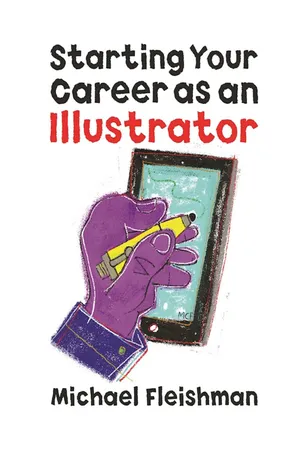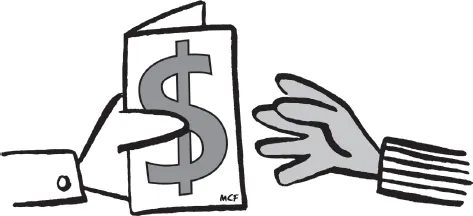![]()
Section III
Taking Charge
![]()
Chapter 8
Clients
Your elevator pitch is not about you. The homepage of your website is not about you. Your pricing isn’t about you. Realize that it’s all about them—your clients and prospects. Master that mindset and you’ll know exactly what to do and say, even in the stickiest of situations.
—Ilise Benun
MATCH GAME
Our opening quote is from Ilise Benun, who offers invaluable business insights and sharp marketing strategies like this through her Marketing-Mentor.com site.
Finding clients who need your services is a bit like working with a dating service. You’re matchmaking, pairing your special abilities with the folks who have the greatest need for them. This sounds simple, but figuring out where to focus your energies involves some thought and planning. It might be best to first break your possibilities down into several categories to isolate where potential business may be. Find out where, and if, the shoe fits. This is a good “problem” to have.
In addition to thinking about where you can market your work, also reflect on your level of proficiency and match your skills accordingly with prospective clients. Consider your illustration style(s) and how this matches up with those potential customers. Does the work in your portfolio display a trendy, freewheeling line style that could appeal to an edgier, younger crowd? Is your illustration tight and lean, maybe traditional or conservative; is it geared to an older market?
If you’re just starting out in your career, it may be prudent to sound out smaller, local clientele before you approach national markets (or even larger concerns in your city). While you don’t need my blessing, it’s just wise to realize that until you’ve gained some experience and credibility, baby steps are okay and nothing to be ashamed of.
Initially, your illustration skills may be better suited to smaller locals than to big-time corporate yokels (found downtown, worldwide). But I’m rather the gut-level, free-range marketer—so if you tack toward “no guts, no glory,” I still say go for it.
BUSINESS IN MIND
We’ve talked in earlier chapters about why illustrators may not be as business-minded as they should be. Likewise, many might not be exceedingly functional salespeople either. Perhaps the problem is one of attitude rather than a lack of ability. Maybe illustrators fear the image of some high-pressure huckster peddling substandard, unwanted goods. Perhaps they hold the mistaken notion that any sales activity is below their creative station.
Total bull. In truth, sales are the lifeblood of our business; so how do we get past these counterproductive notions? It might help to understand that you are calling on clients to see if you can help. So think How can I help you? instead of Do you want to buy? Change the mindset from you selling work to you helping with a snag in communications.
You need to sell. If you’re convinced that by doing so you’re reduced to pushing snake oil, your business will go nowhere. It’s crucial that you believe in what you are doing, and what you are doing is solving problems—a most valuable service and worthwhile endeavor. If you must sell something to make a living, creative solutions make for a wonderful product. Don’t you agree?
In this chapter you’ll learn more about how to sell this potent elixir, where to find clients and how to make effective—no, truly dynamic—presentations. You’ll find out how to keep clients hungry for more so you won’t have to go out on a sales hunt after every new job. Let’s get busy!
WHY FREELANCE?
Freedom, self-expression, working for yourself, improving as an illustrator. There are myriad reasons why freelancing is a sweet, productive means to a brilliant, artistic end. And clients are at the heart of the creative matter.
“I love working with clients to produce an image that makes us both happy,” says Julia Minamata. “The problem-solving aspect of illustration really appeals to me. And I think I’m an effective communicator. I hope I am! The only way I’ve been able to judge this is if the client is happy with my work.”
As Kelly White will tell you, there are multiple ways to find clients. “You just have to offer something they’re looking for,” she says, “and do it better than the guy standing next to you who’s trying to get their business too.”
BETTER THAN THE NEXT GUY
So how does one “do it better than the next guy”? One classical approach is to acutely shotgun your customer service. Bil Donovan is of the mindset that, as a professional, his job is to make the life of the client easier. “I know I am there for a reason,” he says, “to provide a solution. And if I am there, that means that the client has seen something in my work that resonates with the project and their vision for the project. That will give you some leverage.”
Donovan says he’s never tried to “sell himself”—it’s just not his style. He feels he is providing a service as a commercial illustrator. If he’s not the right fit, then, as he says, “Rest assured, the job will be problematic. I am respectful and polite, yet firm in not compromising my work. That is foremost in my experience.”
Donovan reiterates that as illustrators, we are in a field of providing a service. “As distasteful as that might sound,” he says, “that is the reality of our position. We are vendors. The client is the client. Think of how you have experienced good and bad customer service and treat the client as you would like to be treated.”
You shouldn’t need Donovan to remind you that politeness goes a long way, that it’s counterproductive to be shy about throwing your ideas into the ring, that you must speak up if you feel your work is being compromised. (Yes, this is a delicate balance, but sometimes necessary.) I’ll bet you also understand that completely engaging in an assignment will win you the confidence and loyalty of your client. Says Donovan, “I enter every project as if it is the most important job I have ever had.”
Do as Donovan does, and on any given day, you will indeed be “doing it better” than the guy next door.
MAKE YOUR MARK (FOLKS JUST LIKE YOU)
SHAPIRO: AN ART DIRECTOR’S POINT OF VIEW
Ellen Shapiro is a New York–based graphic designer who’s been working with freelance illustrators as long as she can remember.
“I’m always trying to sell my clients on the benefits of illustration,” Shapiro says, “but too many of them aren’t buying. They are in love with almost-free stock photography, the speed of it, and the vast number of choices.”
Shapiro, author of many magazine articles about the business of design and illustration and The Graphic Designer’s Guide to Clients (Allworth, 2014), tells us that many clients don’t want to take the time to deal with what she they see as the “uncertainties of illustration”—deciding on a concept, waiting for sketches, revisions, and finished art. “All along, they’re worrying that the CEO or chairman might reject the whole project,” she says. “Clients have already gone through the myriad steps of selecting the design firm and they often don’t want another layer, another creative to deal with, the unknown illustrator who could be a ‘goofy, unreliable, emotional’ artiste.”
But Shapiro works to make the sale anyway, pushing the benefits of illustration. “I emphasize that illustration is much more interesting. It has style. It is conceptual,” she asserts. “But too many clients think that you can just push a button and an illustration pops up. And, unfortunately, with so much free or cheap vector art available, hiring an illustrator is a much harder sell now than it was a decade or two ago.”
And that is why Shapiro urges illustrators to be even better at making art and better still at doing business. “When I sell the idea of illustration, the next hurdle is original illustration, not stock. I tell them, ‘You will get something fresh. None of your competitors will have it. It will distinguish you and your product or service in a way stock could never do. You can be part of its creation.’”
If her clients agree—hallelujah—next comes the hurdle of pricing. Why, clients want to know, should we pay $1,000 or more when there is all that “cool vector art on iStock for one credit, for like $15?”
That’s where an art director’s power of persuasion has to come in. To promote you, they must deal with all that, get approval of the budget, and then, perhaps, haggle with the client about the concept. Says Shapiro: “It will go something like this … Should the bird be in the cage or flying out? Is the heart broken in half or only cracked?’
“Suddenly, every communications manager or business owner is a creative genius!” Shapiro says, with a laugh. “But we have to keep them from getting too creative and make sure they let the illustrator do his or her job. The whole idea is that original illustration, in addition to being beautiful, can be daring, unusual, thought-provoking. I suspect that magazine art directors have an easier time of this than brochure/collateral/website designers.”
As Shapiro points out, this is the moment when most clients reveal how much they fear for their lives. “They waffle when the concept isn’t something safe and predictable,” she says. “I have to be my most professional, experienced, charming, persuasive, and sell the illustrator. And I have to sell the client on the idea of letting the illustrator be the one who will come up with the right concept. In order to do that, I need to be as certain as possible that this artist is going to make me—and my client—into a hero, not a laughingstock.”
So sketches are important. Art directors can’t be left wondering whether they’ve made a good decision. To Shapiro, the whole illustration business boils down to one thing: talent. “ Are you able to take a germ of an idea and transform it into something beautiful and astonishing,” Shapiro asks, “something exciting that communicates what the client needs to say?”
If the sketches are too rough, if Shapiro can’t tell what’s going on, she knows her client won’t have a clue. And if it seems like you spent more time negotiating the contract and usage rights than doing the sketches, she must then ask you some hard questions: Did you have enough time in your schedule to give this assignment justice? Did you think about it deeply, give the project the attention it deserves? Or did you just recycle one of the old ideas in your portfolio—oh no, not that tightrope again!—or copy an idea from last year’s illustration annual winners? “Some illustrators are so good they can communicate a brilliant idea in a scribble,” Shapiro notes, “but can you?”
Finished art often has its own set of challenges: “Does the illustration actually fit the layout?” she asks. “Is it printable? Did you send CMYK artwork for a two-color job (even though the requirements were clear)? Is the concept appropriate? If not, in the end, it won’t matter that your ideas are clever, the style is hip, the colors are beautiful, the characters interesting and diverse,” she says. “If the illustration has a ‘fatal flaw,’ the project will get killed.”
However, when Shapiro looks at the projects her firm has produced over the last few decades, it’s the ones with original illustrations, not photography, that are the most outstanding. These are the assignments that boast the greatest staying power as communications pieces. “They were done in collaboration with freelance illustrators who did their job well, and who ultimately made my client into a hero,” she says with satisfaction.
GET A JOB
“I wish I could say that 100 percent of my clients have been great,” Rick Antolic says with a half smile, “bu...

